Have you ever wondered where are Nike shoes made? With Nike being one of the most popular sportswear brands in the world, it’s natural for buyers to be curious about the origins of their sneakers.
While many people assume Nike shoes are still made in the United States, the truth is that the company now operates on a global scale, with most production happening overseas.
In this guide, we’ll explore the history of Nike’s manufacturing; reveal the main countries where its shoes are produced today, and break down the materials and processes that go into each pair.
Where are Nike Shoes Made? Insights Into the Full Making Process
1. Where Are the Original Nike Shoes Made?
Nike, one of the world’s most iconic sportswear brands, started in the 1960s as Blue Ribbon Sports, founded by Bill Bowerman, a track-and-field coach, and Phil Knight, a former runner.
The company’s first shoes—the ones now considered the original Nike shoes—were manufactured in the United States, primarily in Oregon, where the founders tested designs and sold them to local runners.
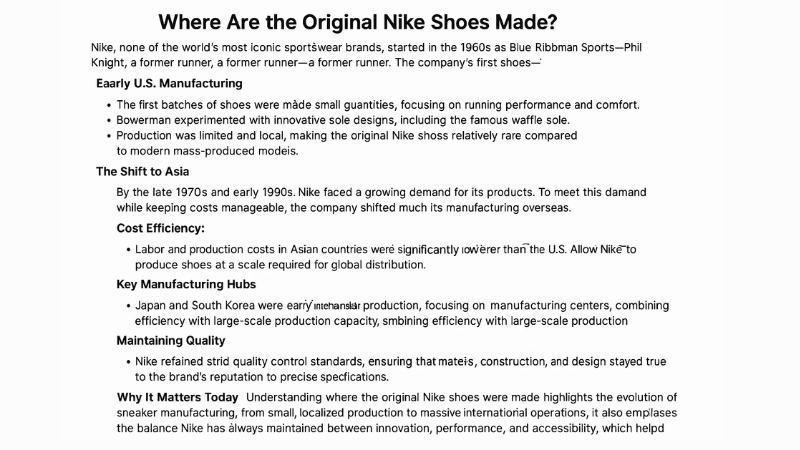
Early U.S. Manufacturing
The first batches of shoes were handmade in small quantities, focusing on running performance and comfort.
Bowerman experimented with innovative sole designs, including the famous waffle sole, which became a signature feature of Nike running shoes.
Production was limited and local, making the original Nike shoes relatively rare compared to modern mass-produced models.
The Shift to Asia
By the late 1970s and early 1980s, Nike faced a growing demand for its products. To meet this demand while keeping costs manageable, the company shifted much of its manufacturing overseas. Key points of this transition include:
- Cost Efficiency:
- Labor and production costs in Asian countries were significantly lower than in the U.S.
- This allowed Nike to produce shoes at a scale required for global distribution.
- Key Manufacturing Hubs:
- Japan and South Korea were early international partners, focusing on high-quality production.
- Later, China, Vietnam, and Indonesia became the primary manufacturing centers, combining efficiency with large-scale production capacity.
- Maintaining Quality:
- Despite moving production overseas, Nike retained strict quality control standards, ensuring that materials, construction, and design stayed true to the brand’s reputation.
- Designs continued to originate in the U.S., with overseas factories producing the shoes according to precise specifications.
Legacy of the Original Nike Shoes
Even though modern Nike shoes are largely manufactured abroad, the original U.S.-made shoes represent the company’s innovative beginnings. Collectors and sneaker enthusiasts value them for:
- Their historical significance in athletic footwear.
- Unique craftsmanship, including handmade soles and original materials.
- The inspiration they provided for Nike’s global expansion.
Why It Matters Today
Understanding where the original Nike shoes were made highlights the evolution of sneaker manufacturing, from small, localized production to massive international operations. It also emphasizes the balance Nike has always maintained between innovation, performance, and accessibility, which helped it become the global brand it is today.
2. Current Nike Manufacturing Locations
Today, Nike shoes are produced almost entirely outside of the United States. The company partners with a massive global supply chain, relying on over 500 factories in more than 40 countries.
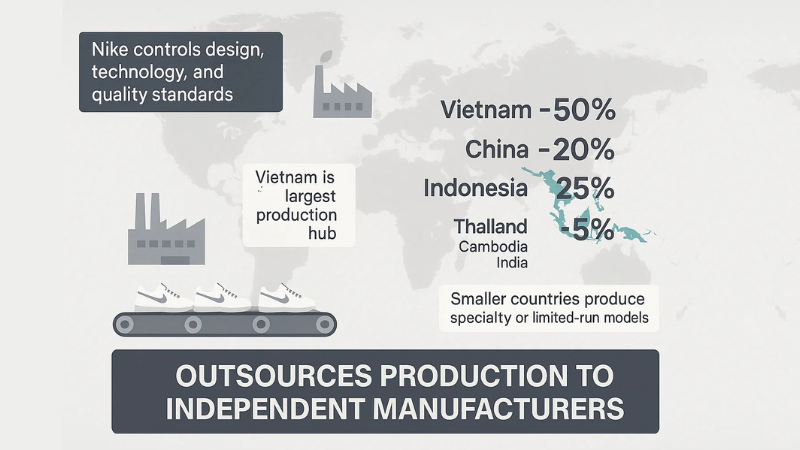
The largest production hubs include:
- Vietnam – Currently the top producer, making nearly 50% of Nike’s shoes.
- China – Another major player, responsible for around 20% of production.
- Indonesia – Accounts for roughly 25% of Nike shoe manufacturing.
- Thailand & Others – Contribute smaller percentages, mainly for specialized models.
It’s important to note that Nike doesn’t own most of these factories. Instead, it outsources production to independent manufacturers, while Nike controls design, technology, and quality standards.
Nike Shoe Production by Country (Approximate %)
Country | Share of Nike Production |
Vietnam | ~50% |
China | ~20% |
Indonesia | ~25% |
Thiland & Others | ~5% |
This breakdown shows that Vietnam is now the largest hub for Nike footwear manufacturing, followed by China and Indonesia. Smaller countries like Thailand, Cambodia, and India contribute to specialty lines or limited production runs.
3. What Are Nike Shoes Made From? (Materials Used)
When talking about where Nike shoes are made from, it’s not just about geography—it’s about the innovative materials and technologies that define each pair. Nike combines performance-driven design with advanced fabrics, sustainable initiatives, and comfort-focused components.
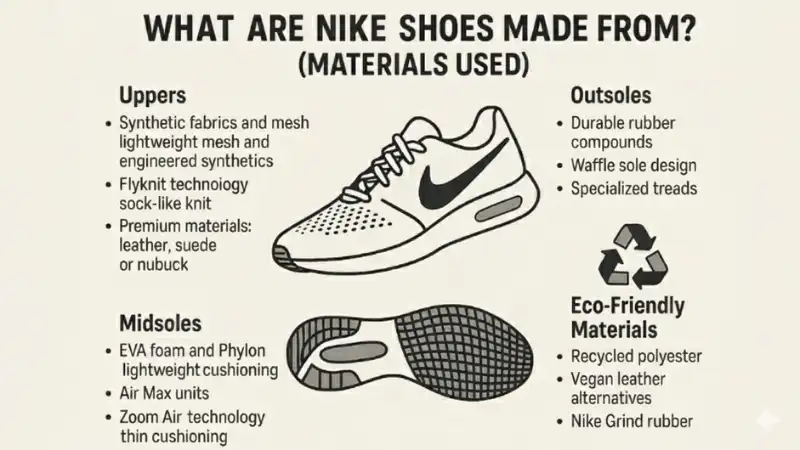
Uppers
The upper portion of Nike shoes—covering the top and sides of your foot—is designed for lightweight support, breathability, and style:
- Synthetic fabrics and mesh:
Most modern Nike shoes use lightweight mesh or engineered synthetics for ventilation and flexibility.
- Flyknit technology:
A patented, seamless knit design that offers sock-like comfort and precise support while reducing material waste.
- Premium materials:
Some high-end or lifestyle models incorporate leather, suede, or nubuck, providing durability and a premium look.
Midsoles
The midsole is the heart of comfort and performance, absorbing impact and enhancing energy return:
- EVA foam and Phylon:
Lightweight cushioning materials that provide basic comfort and support.
- Air Max units:
Pressurized air pockets in the sole for impact protection and springy responsiveness.
- Zoom Air technology:
Thin, responsive cushioning for fast, low-profile performance in running and training shoes.
Outsoles
The outsole ensures traction, stability, and durability:
- Durable rubber compounds:
Protect against wear while maintaining flexibility.
- Waffle sole design:
Nike’s signature design innovation since the 1970s, offering superior grip and natural movement.
- Specialized treads:
Some shoes use patterns optimized for basketball, running, or trail use, enhancing performance on different surfaces.
Eco-Friendly Materials
Nike’s Move to Zero initiative focuses on reducing environmental impact:
- Recycled polyester:
Used in uppers, laces, and linings.
- Vegan leather alternatives:
Reduces reliance on animal products.
- Nike Grind rubber:
Made from old shoes and factory scraps, repurposed for soles and midsoles.
Key Takeaway
Modern Nike shoes are a blend of synthetic, natural, and recycled materials, all engineered for performance, comfort, and sustainability. By combining innovative fabrics, advanced cushioning, and eco-conscious components, Nike continues to set the standard for athletic and lifestyle footwear.
To choose sneakers that balance comfort and performance, see Best Sneakers for Nurses.
4. Are Nike Shoes Made by Hand?
If you’re wondering “are Nike shoes made by hand?”, the answer is: partially. Modern Nike footwear is produced using a blend of skilled craftsmanship and advanced machine automation, combining precision, efficiency, and quality.
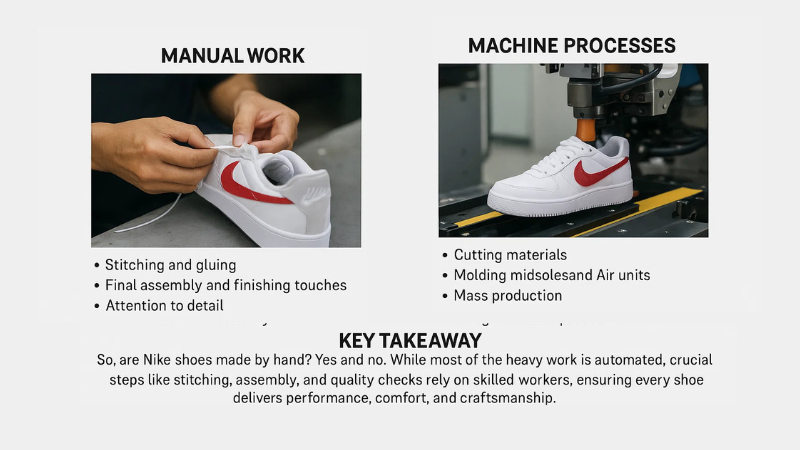
Manual Work
Certain critical steps in the shoe-making process still rely on human hands:
- Stitching and gluing:
Workers carefully assemble uppers, attach soles, and ensure components align perfectly.
- Final assembly and finishing touches:
Quality control, polishing, and minor adjustments are mostly done by hand to guarantee each shoe meets Nike’s standards.
- Attention to detail:
Human oversight is essential to catch imperfections that machines might miss, ensuring comfort and durability.
Machine Processes
Machines handle the bulk of production tasks, allowing Nike to scale efficiently while maintaining consistent quality:
- Cutting materials:
Synthetic fabrics, leather, and mesh are precision-cut by automated systems.
- Molding midsoles and Air units:
Automated presses shape the cushioning systems for performance and durability.
- Mass production:
Machines allow Nike to produce millions of shoes annually without sacrificing structural integrity.
Why This Combination Matters
The balance of handcraft and automation gives Nike shoes their signature:
- Durability and comfort through precise human assembly.
- Efficiency and consistency through machine production.
- The ability to meet global demand while maintaining high performance standards.
Key Takeaway
So, are Nike shoes made by hand? Yes and no. While most of the heavy work is automated, crucial steps like stitching, assembly, and quality checks rely on skilled workers, ensuring every shoe delivers performance, comfort, and craftsmanship.
To choose the shoes that combine comfort and support, see Best Shoes for Nurses.
5. Are Nike Shoes Made of Real Leather?
Nike uses a mix of real leather and synthetic materials, depending on the shoe line and purpose.
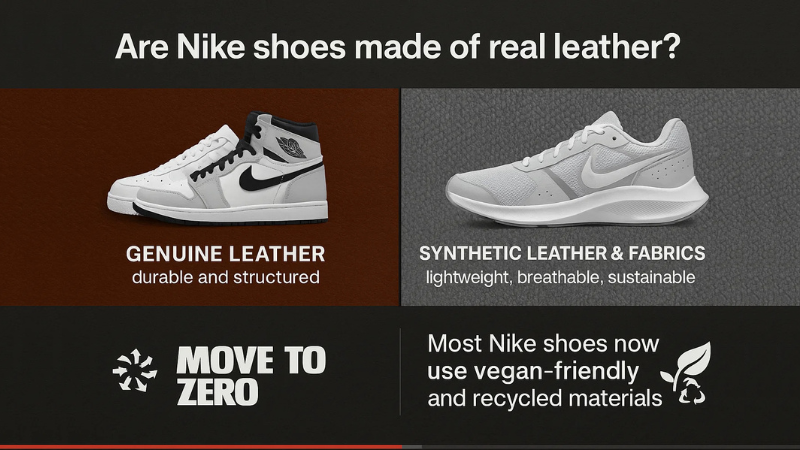
- Genuine Leather Use:
Classic and premium models such as the Nike Air Force 1, Air Jordans, and select lifestyle sneakers often feature genuine leather uppers. These are valued for durability, structure, and a timeless look. As these shoes are genuine leather, you need to be careful not to damage the material when cleaning them.
- Synthetic Leather & Fabrics:
Many of Nike’s modern shoes, especially running and training sneakers, rely on synthetic leather, mesh, Flyknit, and engineered fabrics. These materials are lighter, breathable, and often more sustainable than real leather.
- Sustainability Shift:
Nike is increasingly moving toward vegan-friendly and recycled alternatives. Through its “Move to Zero” initiative, the brand is reducing reliance on animal products and embracing eco-friendly materials.
Answering the question: are Nike shoes made of real leather — yes, but only select models use genuine leather, while most rely on synthetics and innovative textiles for performance and sustainability.
6. How to Identify Authentic Nike Shoes
Nike’s global popularity makes it one of the most counterfeited brands in the world. Knowing how to spot a genuine pair ensures you get the quality, comfort, and durability that Nike promises.
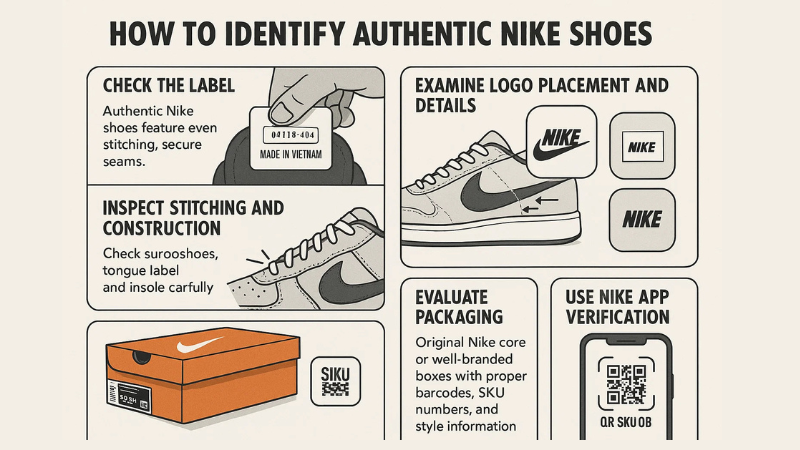
Check the Label
Authentic Nike shoes always list the manufacturing country on the inside tag—common locations include Vietnam, China, and Indonesia.
Seeing a tag that simply says “Made in Asia” doesn’t automatically mean the shoes are fake, but always compare the tag details with official Nike references.
Inspect Stitching and Construction
Genuine Nike shoes feature even stitching, secure seams, and high-quality glue application.
Watch for loose threads, uneven stitches, or sloppy assembly, which are common signs of counterfeit shoes.
Examine Logo Placement and Details
- Check the Swoosh, tongue label, and insole carefully.
- Misaligned logos, off-center printing, unusual fonts, or inconsistent details often indicate fake products.
Evaluate Packaging
Original Nike shoes come in well-branded boxes with proper barcodes, SKU numbers, and style information. Counterfeit boxes may have faded printing, incorrect codes, or missing labels.
Use Nike App Verification
For newer models, the Nike app allows you to scan QR codes or SKU numbers to verify authenticity. This digital check is especially useful when buying online or from resellers.
Key Takeaway
By paying close attention to labels, stitching, logos, packaging, and digital verification, you can confidently distinguish real Nike shoes from fakes. This ensures that every pair you buy delivers the performance, comfort, and durability that define the brand.
7. Nike’s Ethical & Sustainability Efforts
Nike has taken significant steps toward ethical manufacturing and sustainability, although the company continues to face scrutiny and challenges. Understanding these efforts helps consumers make informed choices when purchasing Nike products.
Fair Labor Standards
Nike partners with independent factories worldwide to produce its shoes and apparel.Over the years, the company has improved labor practices, but reports of violations occasionally surface.
To address this, Nike implements regular audits, compliance programs, and worker training to ensure safe and fair working conditions. While not perfect, these efforts show a commitment to responsible manufacturing across a global supply chain.
Move to Zero Initiative
Nike’s Move to Zero campaign is a bold effort to reduce carbon footprint and environmental impact:
- Recycled materials:
Incorporates recycled polyester, rubber, and other components in shoes and apparel.
- Waste and emissions reduction:
Optimizes production processes to minimize environmental impact.
- Circularity:
Encourages reuse of materials from old shoes through recycling programs and Nike Grind products.
Eco-Friendly Materials
Many Nike products now feature sustainable alternatives designed to reduce environmental harm:
- Vegan leather:
Reduces reliance on animal products.
- Flyleather:
Made with at least 50% recycled leather fibers, combining durability with eco-conscious design.
- Recycled foam midsoles:
Lightweight, performance-driven, and environmentally responsible.
Key Takeaway
By combining ethical labor practices with eco-conscious materials and initiatives, Nike aims to create a more sustainable and responsible global production system. While challenges remain, programs like Move to Zero reflect a clear commitment to minimizing environmental impact while delivering high-performance footwear.
Conclusion
To recap, Nike shoes are made primarily in Asia, with Vietnam, China, and Indonesia being the top production countries. While the brand started in the United States, global demand and cost efficiency have shifted most manufacturing overseas.
Nike shoes combine handmade craftsmanship and machine automation, ensuring quality and precision in every pair. Leather is used only in select premium or classic models, while most shoes rely on synthetic, breathable, and eco-friendly materials. With just a little care, you can easily make them last a long time.
By understanding where and how Nike shoes are made, consumers can make informed purchasing decisions, recognize authentic products, and appreciate the sustainability efforts behind each pair.
FAQs About Nike Shoe Manufacturing
Are Nike shoes made in the USA anymore?
Most Nike shoes are now manufactured overseas. Only a few specialty or limited-edition models are produced in the United States.
What percentage of Nike shoes are made in Vietnam?
Approximately 50% of Nike shoes are produced in Vietnam, making it the largest manufacturing hub.
Does “Made in China” mean fake Nikes?
No. Many authentic Nike shoes are manufactured in China. The country produces a significant portion of Nike footwear alongside Vietnam and Indonesia.
Are handmade Nike shoes better quality?
Handmade elements ensure precision in stitching, assembly, and quality control, but overall durability also depends on the model and materials used. Nike combines handcraft with advanced machinery for consistency.
Which Nike models use real leather?
Premium or classic models, including the Air Force 1, Air Jordan’s, and select lifestyle sneakers, often use genuine leather. Most performance or modern running shoes use synthetic materials instead.

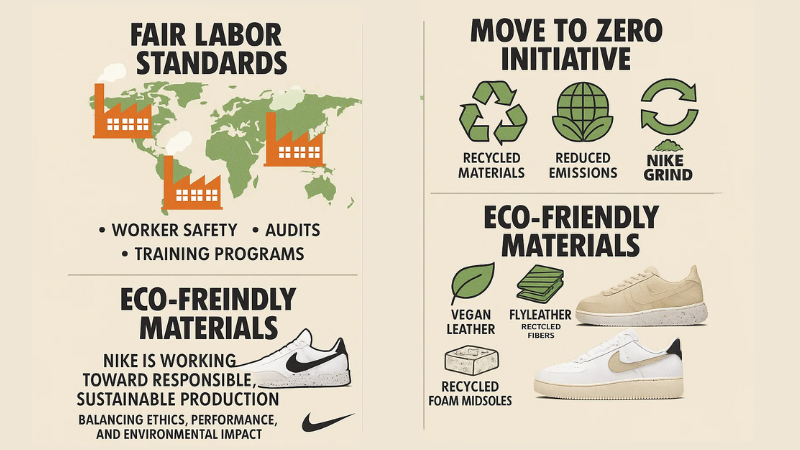
Leave a Reply